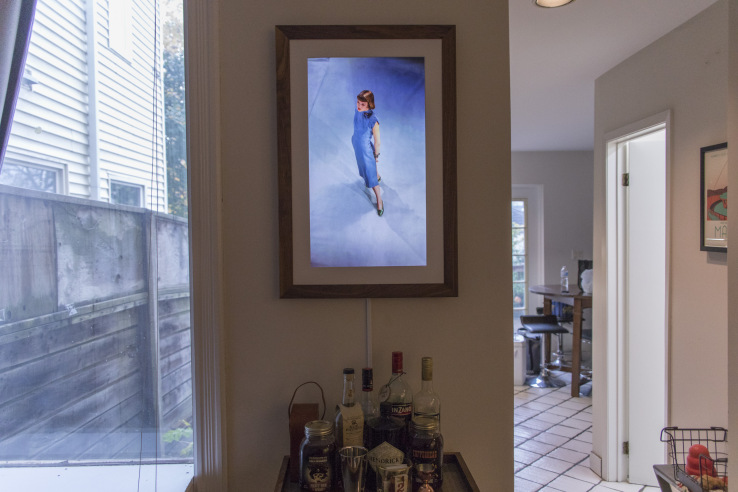

Meural’s second-generation Canvas digital art display is now available, and I’ve been testing one out for the past couple of weeks to see how it stacks up. This is my first experience with any kind of digital canvas product, and I have to admit I had very low expectations going into it – but the Meural is actually an outstanding gadget, provided you have the means to commit to it, including the base price of purchase and the add-on subscription that Meural also launched to keep it populated with a broad library of content.
The Meural Canvas retails for $595 or $695 depending on your preferred frame finish, and includes a 27-inch diagonal full HD (1080P) display. The screen features a glare-free finish, a maximum brightness of 300c/m2, and an auto-dimming feature to help it match the ambient light in the room. The frame also includes Wi-Fi connectivity, with up to 802.11 ac speeds across both 2.4GHz and 5GHz channels, and there’s a computer inside powering the whole thing with a 1.8HGz Quad Core ARM processor, a Cortex-A17 graphics chip, 2GB of RAM and 8GB of onboard storage.
The specs are good, but the best part about them is that once you’re up and running with the Canvas (and setup is easy, using the companion mobile app to connect to your Wi-Fi in just a few minutes), you never have to think about them again. Canvas does its job so well you’ll forget it’s a wall-hanging computer, in fact, and come to think of it more like a magical painting whose contents can change, Harry Potter-style, in an instant – and which even supports artwork with motion elements, including large-format cinemagraphs.

Canvas’ real strength is in its proprietary display tech, which combines that glare-free screen with intelligent matching for the room lighting and an uncanny ability to make digital images look like they’re printed or even painted: Depending on your room lighting, the Meural hardware looks like it actually is a genuine painting, and the effect is particularly amazing in well-lit rooms with a lot of natural light.
All of this comes at a slight cost in terms of installation requirements, since there’s a power cord supplying the energy needed to run the Canvas. The included cord is a braided white nylon affair which is durable and relatively easy to hide away, however: I ran a cable holder like you might use for a wall-mounted TV to disguise mine, and I’ve received a number of compliments on how well it blends in with the rest of the decor. And in terms of power costs, they’re minimal – the Canvas only uses the equivalent of less than half of that of a standard light bulb.
The physical dimensions of the Canvas itself are also something you need to take into consideration when thinking about buying this, since it’s 30.4-inches by 20-inches, which is likely to take up a decent amount of wall space for many. It was perfect for my high-ceiling apartment on the main floor of a house, however, and truly stands out as a decorative feature regardless of what’s begin shown in the frame, especially in the attractive walnut frame finish ‘Winslow’ model I tested.
To choose what your Meural Canvas shows, you can either navigate to the web interface or use the mobile app. On the web, you can browse a wide variety of collections curated by Meural, some of which are limited to its subscription service, which is available for $4.95 per month or $39.95 per year. The Mural Membership provides access to the entire library, and exclusive feature collections and editorial curation, however. Plus, if you don’t want to pay, you can also upload any of your own art and organize it into playlists, too.

Meural also offers a number of different options for how it displays art, including adjustable brightness (or automatic adaptive), duration of time each piece in a collection is shown, whether it’ll rotate through the various collections you have on your Canvas, and whether it’ll display horizontal/vertical/cropped images or any mix of the above.
In the box, there’s mounting hardware included which makes it dead simple to install, even if you’re not particularly handy, and you can rotate the Canvas at any time using the clever anchor and frame mount design.
Some critics have noted that Meural’s Canvas might not have the highest resolution display (it’s HD in an age of increasingly 4K and Retina screens), but this turned out to be a non-issue for me. The viewing distance for the screen is such that you’re not going to notice any pixelation anyway, and the Meural team has focused on aspects that matter more, including even backlighting, adaptive brightness, proper color rendering and better viewing angles.
One unexpected benefit of Meural’s Canvas: It got me doing some with my own photography besides storing it in the cloud. I always have good intentions to print some of my favorite shots from my travel photography, but I never actually do – on the Canvas, it’s as easy as uploading the images via your desktop browser and creating your own playlists. You can even include photo credits and contextual details, in case you really want to show off.
This might be the real target demo sweet spot for Canvas: Artists and photographers who want a personal showcase without the printing. But it’s actually a fantastic addition to any household, provided spending $600 or so on a screen with a very specific purpose makes sense to you. Honestly, I didn’t think it would with the Meural Canvas, but testing the latest generation of the digital frame proved otherwise.

